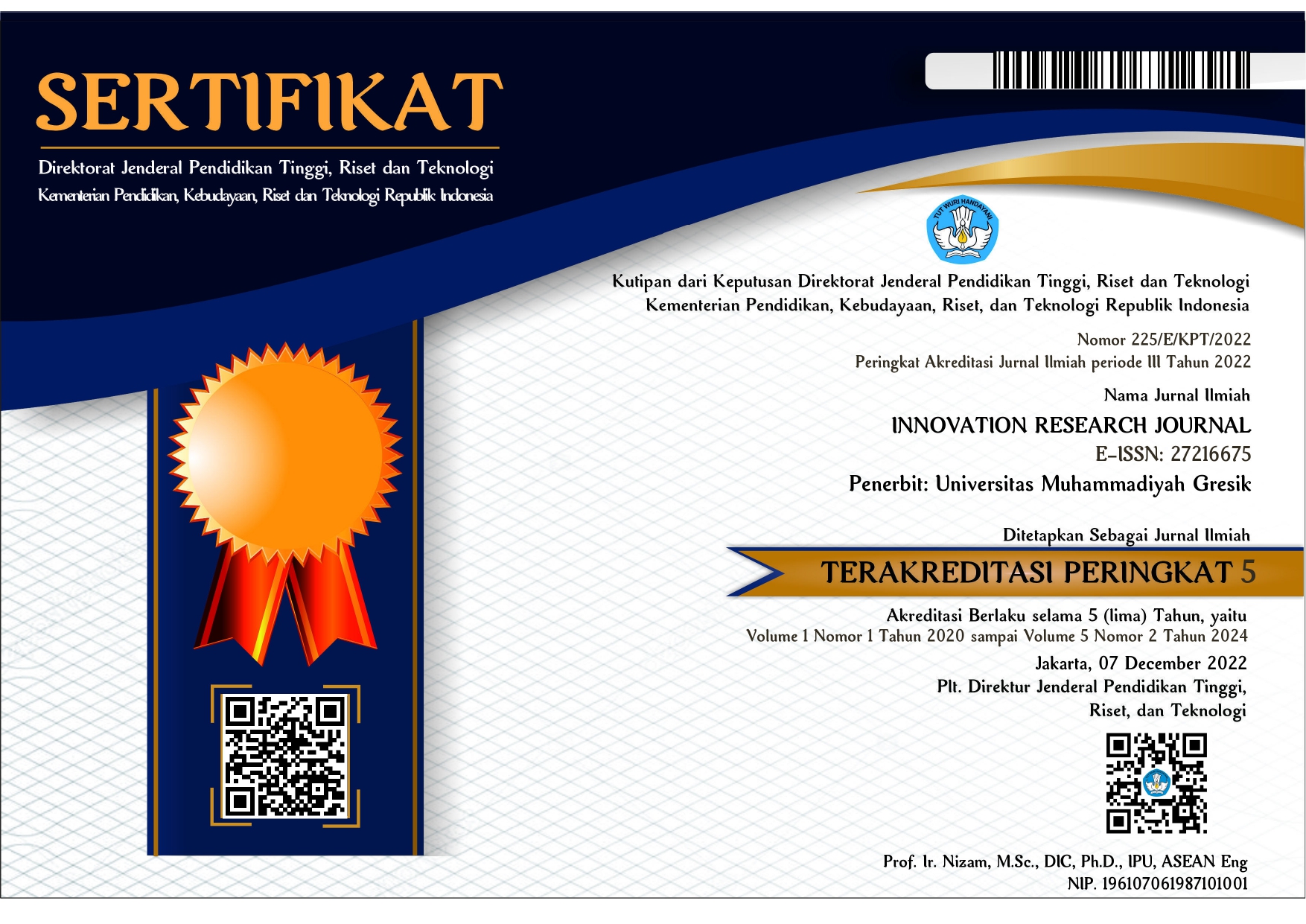The Relationship Between Response Time and The Effect of Hospitalization on Preschoolers
DOI:
https://doi.org/10.30587/innovation.v5i2.8369Keywords:
Hospitalization Effect, Response TimeAbstract
Objective : Response time is the speed of health workers in treating patients starting from the time the patient comes to the emergency room until he gets health care . The indicator of success is the speed of officers in providing assistance to emergency patients ≤ 5 minutes. One of the first units to go to at the hospital is the emergency room. In children, not all treatments given are acceptable and even these treatments can have an impact or effect on the child's hospitalization. This study aims to analyze the correlation between response time and the effect of hospitalization on preschool children in the emergency room of the Muhammadiyah Gresik hospital.
Methods : This type of research is analytic with a cross-sectional approach with a patient population of preschool children (3-6 years) who come to the emergency room of the Muhammadiyah Gresik hospital with a total of 132 children as respondents. And using purposive sampling method. Data analysis in this study used the Chi-Square test to determine the relationship between response time and the effect of hospitalization on preschool children with a significant p value = <0.05.
Results : Preschoolers children in the emergency room of Muhammadiyah Gresik hospital Most (54.5%) experienced the effects of anxious hospitalization, namely as many as 72 children. Response time of nurses to preschool children in the emergency room of the Muhammadiyah Gresik hospital, almost all of them were fast (89.4%), namely 118 children..
Conclusion : There is no correlation between response time and the effects of hospitalization in preschool children with a p-value = 0.056
Keywords: Hospitalization Effect, Response Time
References
Doondori, A. K., Sekunda, M., Cahyani, S. L., & Kurnia, T. A. (2019). Nurse Response Time in Providing Services with Patient Satisfaction in the Emergency Installation. Journal of Primary Health, 4(2), 76–83. https://jurnal.akperdharmawacana.ac.id/index.php/wacana/article/view/281
Firmansyah, H., Badia'ah, A., Lani, T., Irianti, D., & Ariani, M. (2021). Theory and Research-Based Child Health Nursing (A. Munandar (ed.); first). Indonesia science media and writers.
Handriana, I. (2016). Pediatric Nursing (First). LovRinz Publishing. Pediatric https://books.google.co.id/books?id=gVQrEAAAQBAJ&lpg=PA175&dq=Keperawatan&pg=PA175#v=onepage&q=Pediatric Nursing&f=false
Hania, U. P., Budiharto, I., & Yulanda, N. A. (2020). Literature Review: Factors Affecting Nurses' Response Time in Emergency Room Treatment. Encyclopedia of Algorithms, 56, 777. https://doi.org/10.1007/978-0-387-30162-4_343
Hidayattullah, R., & Permatasari, I. (2020). Puzzle and Playdough Play Therapy to Overcome Anxiety Due to Hospitalization in Preschoolers (3-6 Years Old) (First). Canva Premium.
Karokaro, T. M., Hayati, K., Sitepu, S. D. E. U., & Sitepu, A. L. (2020). Factors related to the patient's response time in the emergency department of Grandmed Hospital. Journal of Nursing and Physiotherapy (JKF), 2(2), 172–180. https://doi.org/10.35451/jkf.v2i2.356
Kartika, L., Ani, M., Mariyana, R., Yudianto, A., Wijayati, S., & Sitompul, M. (2021). basic pediatric nursing (First). Our Writing Foundation.
Ministry of Health, N.: 129/Menkes/SK/II/. (2008). Minimum Service Standards for Hospitals.
Khairani, A. I., & Olivia, N. (2018). The Effect of Hospitalization on the Anxiety Level of Preschool Children at Tk II Putri Hijau Kesdam I/BB Medan Hospital. Hesti Medan Akper Kesdam I/BB Medan Research Journal, 3(2), 82. https://doi.org/10.34008/jurhesti.v3i2.49
Mudatsir, S., Sangkala, M. S., & Setyawati, A. (2017). Related Factors of Response Time in Handling Head Injury in Emergency Unit of Prof . Dr . H . M . Anwar Makkatutu. Indonesian Contemporary Nursing Jurnal, 2(1), 1–12.
Nurlaila. (2018). Pediatric Nursing Textbook (Anwar (ed.); First). PT. Leutila Nouvalitera.
Nursalam. (2018). Research methodology of Nursing Science. Salemba Medika.
Paula, V., Trisnadewi, N. W., Oktaviani, N. P. W., Hadiansyah, T., Mukhoirotin, Widodo, D., Florensa, M. V. A., Nasution, R. A., & Marliana, T. (2021). Advanced Psychiatric Nursing (R. Watrianthos (ed.)). Our Writing Foundation.
Pawiliyah, P., & Marlenis, L. (2019). The Effect of Storytelling Play Therapy with Reduced Anxiety Levels in Preschool Children Due to Hospitalization. Silampari Journal of Nursing, 3(1), 271–280. https://doi.org/10.31539/jks.v3i1.788
Permenkes, N. 47. (2018). Emergency Services.
Purwari, N. H., & Sulastri, T. (2019). Pediatric Nursing (S. Tharmapalan (ed.); 1st ed.). Hooi Ping Che.
Rantina, M., Hasmalena, & Nengsih, Y. K. (2021). Guidebook for Early Stimulation and Detection of Growth and Development of Children Aged 0-6 Years (M. Habiburrahman (ed.); Second). EDU PUBLISHER.
Rimar, N. L., & Permatasari, I. (2022). Storytelling with the media of puppet fingger (First). CV. Media Sains Indonesia.
Sahensolar, L. N., Bidjuni, H., & Kallo, V. (2021). Overview of the level of patient emergency at the Emergency Installation (IGD) of Bhayangkara Hospital, Manado City. Journal of Nursing, 9(1), 1. https://doi.org/10.35790/jkp.v9i1.36763
Saputro, H., & Fazrin, I. (2017). Sick children are obliged to play in sick children: the application of play therapy for sick children; Process, Benefits and Implementation (E. Agustina (ed.)). Health Scientific Forum.
Sari, F. S., & Batubara, I. M. (2017). Children's anxiety during hospitalization. Kusuma Husada Health Journal, 2008, 144–149. https://doi.org/10.34035/jk.v8i2.233
Sudaryono. (2021). Statistics I: Descriptive Statistics for Research (Giovanny (ed.)). ANDI Publishers.
Utomo, H., Tanziha, I., Arifin, J., & Noegroho, S. (2021). Profile of Indonesia Children (A. P. Bungsu & I. Lukitasari (eds.)). Ministry of Agriculture.









